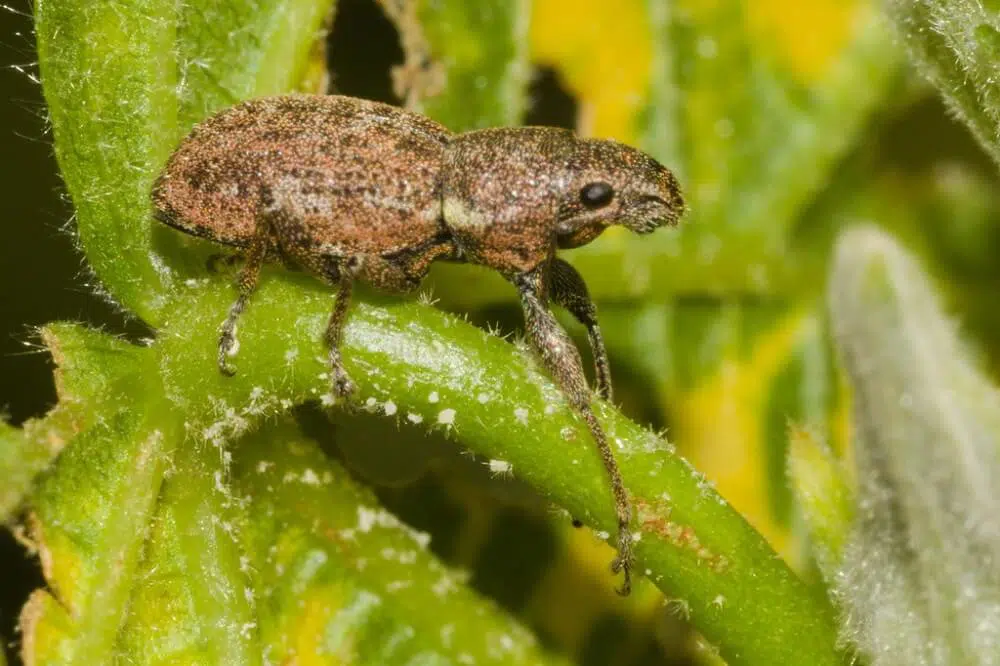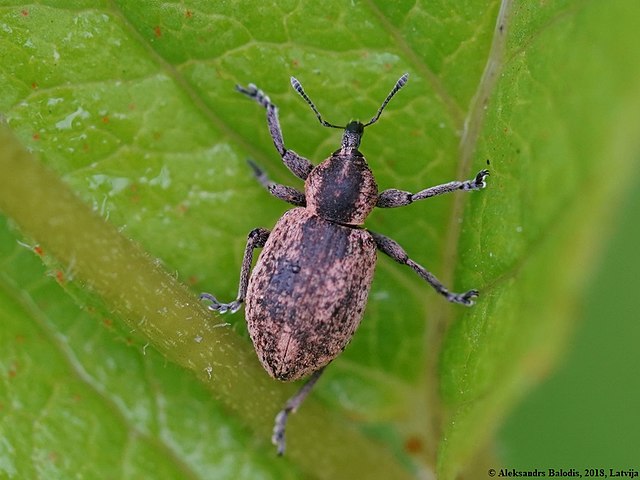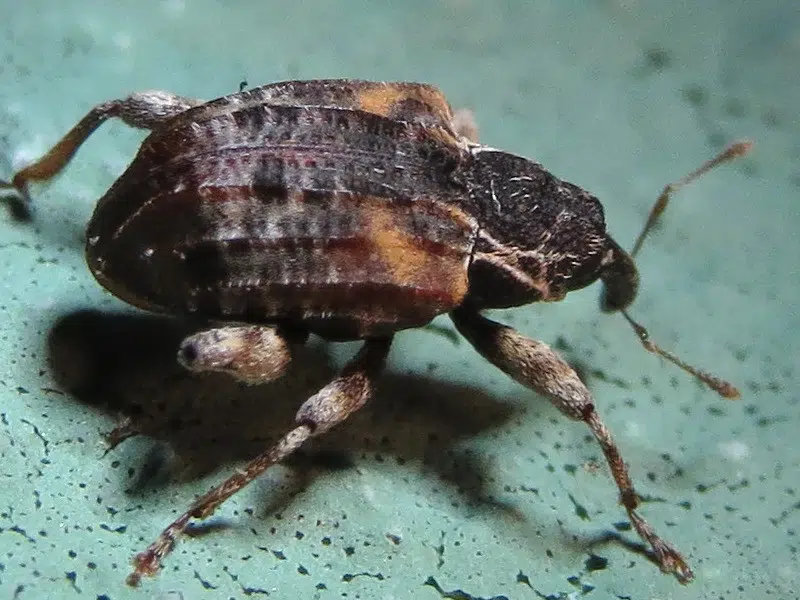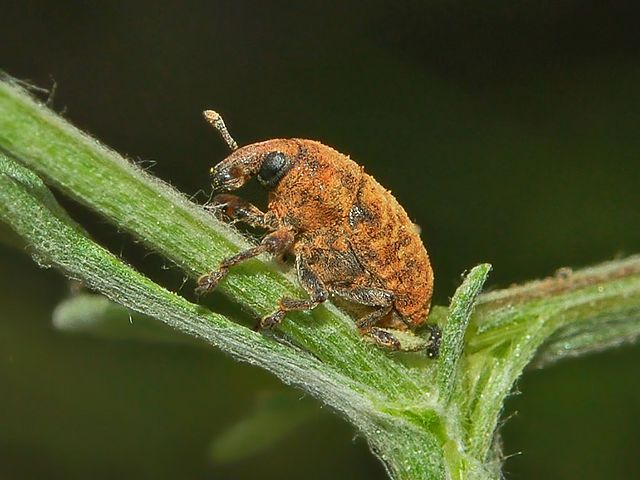Weevils are a type of small beetle. They are known for a long snout and a small body that comes in various colors. There are tens of thousands of types of Weevils. Part of the Curculionoidea family, weevils are often seen as dangerous pests.
Some types of weevils are known for eating stored grains while other pest weevils are known to kill crops by reproducing inside cotton balls.
Table of Contents
What Are Weevils
Weevils or snout beetles are known for feeding with plants. They have long snouts used to pierce certain foods as well as to create holes in which they lay eggs.
Weevil Identification
Weevils are a type of elongated insect with a long snout. These insects grow to around 0.6 inches when they get plenty of food. Both the larvae and weevils themselves only eat plants.
What Do Weevils Look Like

Weevils are insects of the Curculionidae and the Bruchidae family. Most of them have long snouts while those of the Bruchidae family don’t’ have long snouts.
They can be identified by short pointy antennae. These antennae are always found in the middle of the snout.
Apart from a long head and snout, these insects are also known for sometimes coming with scales and hairs.
Behavior
Weevils are the most destructive inhabits. They eat foods such as those in crops and they destructively lay eggs as well.
One of the most damaging habits of weevils is laying eggs in the ground next to roots. Emerging larvae feed on various plant and vegetable roots eventually killing the plant.
Habitat and Distribution
Weevils are always found in high moisture habitats. They prefer warm places. Most weevils aren’t active during the winter.
Its estimated there are more than 3.000 species of weevils in North America. Most of them aren’t native as they were accidentally introduced or have migrated to the US.
Weevils such as the Boll Weevils have made their way to the US from Mexico more than 2 centuries ago. Destruction of the cotton fields was among the first reported results of this invasion.
Types of Weevils
The following types of weevils are the most common by distribution.
1. Asian Oak Weevil

The Asian Oak Weevil (Cyrtepistomus castaneus) is one of the most common species in the US. It was first identified in New Jersey in 1933.
It has since spread out across multiple states.
This is a small green weevil that only grows to 0.3 inches. However, it damages oak loaves as it lays eggs in the ground next to oak roots. As it grows, it moves up oak trees eating the leaves.
Asian Oak Weevils routinely enter the house as pests, mainly to escape the cold winter weather.
2. Green Immigrant Leaf Weevil

Green Immigrant Leaf Weevils (Polydrusus formosus) are another small green weevil species common throughout the world.
It’s distinguished by a metallic green body and green legs.
This type of weevil is one of the most damaging species. It attacks both woodlands trees and fruit-bearing trees.
Mostly active until August, it lays eggs in the ground which complete its larvae stage in the fall. They overwinter in the ground emerging as weevils in the spring, normally until April.
3. Peach Root Weevil

Peach Root Weevils (Pseudoedophrys hilleri) are another type of weevils introduced to the US from abroad. This Japanese-native weevil has a distinct bark-like gray-brown appearance.
These weevils are known to be common in woodlands. They are among the most dangerous pests maple trees have to deal with in the summer.
4. Black Vine Weevil

The Black Vine Weevil (Otiorhynchus sulcatus) made its way to the US from Europe.
Like other weevils, the species is known as a pest. It feeds on leave edges from various flowers such as those of the Camellia genus.
These flowers are impacted to a high degree by the genus as the female Black Vine Weevil can reproduce asexually (parthenogenesis reproduction) which means it creates many offspring fast.
Manually removing these weevils as well as creating physical barriers to stop them from reaching the flowers are among the recommended options to minimize the impact Black Vine Weevils have on Camellia and Rhododendron flowers.
5. Diaprepes Root Weevil

Diaprepes Root Weevils (Diaprepes abbreviatus) made their way to the US through Florida from the Caribbean.
It’s believed these weevils made their way to the US with flower imports.
The species is considered a major pest as it attacks a wide range of plants. Unlike other weevils in the US, Diaprepes Root Weevils attack a wide range of citruses, vegetables, fruits plus ornamental plants.
These weevils can be identified by a yellow-orange body with black stripes and a black head with black antennae. Their legs are also mostly black.
6. Sri Lanka Weevil

Sri Lanka Weevils (Myllocerus undecimpustulatus) are common in Florida. They are recognized by a black and white body with similar coloring on the legs.
These weevils stand out as almost white bugs when seen on green leaves.
Sri Lanka Weevils are considered a major pest that’s hard to deal with.
This species is known for attacking and eating the leaves of fruits and vegetables. These weevils are almost immune to classic insecticides as they can fly away with their long wings.
Manually removing the Sri Lanka Weevils is the only pest management solution with high efficiency in pest control plans.
7. White-fringed Weevil

White-fringed Weevils (Naupactus leucoloma) grow up to 0.9mm. They have a hairy golden-brown body with dark lines running across the edge of the body.
The White-fringed Weevil is a documented species, mostly for its negative impact on crops.
These weevils have been known for triggering local quarantines as a pest management solution multiple times in the past.
White-fringed Weevils are confirmed to attack almost 400 plant species.
Rotating legume crops on a multi-year basis changes roots in the ground deterring these weevils.
Other extreme measures in habitats with high White-fringed Weevils include planting fiber-rich plants such as short wheat which is hard for the weevils to chew.
8. Fuller’s Rose Weevil

The Fuller’s Rose Weevil (Pantomorus cervinus) has a gray-brown color. It gets its name from the rose flowers it likes to attack, even if it has been discovered on a wider range of flowers.
This is a cosmopolitan species which means it has a varied habitat.
Fuller’s Rose Weevils are found in North and South America in high numbers. They’re also common in Europe and Africa, but not as extensively.
These weevils have become a rose export issue a few decades ago when they were discovered on roses from California that ended up in Japan.
They are known to attack the leaves of roses, camellias, and other similar flowers both as larvae and as adults.
Weevils of the genus overwinter next to the roots of the plant which means they never truly go away.
A combination of chemical and mechanical solutions is often considered on rose plantations to eliminate the species.
9. Cocklebur Weevil

The Cocklebur Weevil (Rhodobaenus quinquepunctatus) is known for its boring capacity, which makes it one of the most considerable bugs that damage agricultural fields.
The species is identified by an orange-black or a red-black body which makes it stand out.
Weevils of the genus bore into ragweed, sunflower, and cocklebur with a significant impact.
10. Clover Leaf Weevil

As its name suggests, this species (Brachypera zoilus) is mostly tied to clover and clover fields.
It resembles many species of weevils and identification is first based on its habitat as a result. It has a gray body with pale yellow-brown stripes. It grows to 0.5 inches.
The specie is now found around the US as well as throughout Europe.
11. Strawberry Root Weevil

Strawberry Root Weevils (Otiorhynchus ovatus) have a dark brown shiny body. This color is uniform across its head, legs, antennae, and snout.
The genus is known for attacking strawberries and it often makes its way indoors as many people grow strawberries around the house.
These weevils are harmless indoors.
They cannot sting people and they run away when seeing people. However, they can attack all strawberry roots when strawberries are planted in the garden or on crops on an industrial scale.
12. Milkweed Stem Weevil

Milkweed Stem Weevils (Rhyssomatus lineaticollis) are known in most states in the Eastern part of the US. Their presence is expanding towards the West Coast.
The weevils are recognized by a black body with a long black snout.
These are a type of weevils with considerable impact on milkweed. They have been named among the species which impact endangered Asclepias meadii the most.
This is a very rare type of milkweed that is seeing a steep decrease in its genus and it now only grows naturally in 2 US states (Missouri and Illinois).
13. Two-banded Japanese Weevil

The Two-banded Japanese Weevil (Pseudocneorhinus bifasciatus) has accidentally made it to the US more than a couple of centuries ago.
The species has a faded brown body with a few black strips that run along its body. Maximum size of 0.2 inches is characteristic of the species.
Weevils of the genus aren’t considered as destructive as other weevils as they only eat leave edges.
Two-banded Japanese Weevils are highly common around lilac, rose, and other decorative flowers.
14. Canada Thistle Bud Weevil

The Canada Thistle Bud Weevil (Larinus carlinae) is identified by a black body that only grows to about 10mm.
This species is native to England and countries in Eastern Europe, unlike its name suggests.
It has made its way to North America through Canada. Weevils of this species are known to feed on a thistle.
In Canada, weevils of this group have been used for the biological control of harmful thistle of the Canada thistle genus.
Weevils of this family eat the leaves of this harmful thistle both as larvae and as adults.
15. Yellow Poplar Weevil

As its name suggests, this weevil species (Odontopus calceatus) is common in the US in the regions with yellow poplar.
Weevils of the genus are small and black. They are known for damaging yellow poplar leaves.
However, their reduced size always makes them a good target for predators which generally keep their populations low also limiting their damages.
These weevils are also known to suffer considerable population losses each summer due to parasites.
Pesticides are often used around these trees to further reduce the cosmetic damage to the leaves.
16. Clover Weevil

Clover Weevils (Sitona hispidulus) are known for a dark gray body with marks and spots which offer it a camouflage-like appearance.
These weevils are very active during the summer when they attack clover and alfalfa.
Native to Europe and now widespread in the US, these weevils are also known to overwinter as larvae in the ground. They emerge as adults next to clover fields in the spring.
17. Ironweed Curculio

This orange and black weevil (Rhodobaenus tredecimpunctatus) is known for its resemblance to ladybugs.
However, it has an elongated flattened body compared to ladybugs.
Ironweed Curculio weevils are high common in Mexico and neighboring US states.
As its name suggests, it attacks ironweed. But it’s also a known problem for cocklebur.
18. Sesbania Clown Weevil

These weevils (Eudiagogus pulcher) are common throughout North America.
They look distinct with 2 wide black strips that run across the abdomen and 2 black marks on the head.
Weevils of the genus are also known for having a golden-orange coloring both on the body and on the head.
19. Rough Strawberry Root Weevil

The Rough Strawberry Root Weevil (Otiorhynchus rugosostriatus) has an amber-brown body covered in short white hairs.
Now common in the US, this species has been introduced to North America by accident. It’s believed it has made its way to the country via rose trading.
These weevils are known to attach both leaves and roots of roses. They are distinct from other species of weevils in locomotion as they cannot fly.
20. Odontocorynus salebrosus

This species has multiple other names. It’s known for having over 30 different names.
All of its names describe a single species known for a shiny black body, a blackhead, and black legs.
Its snout and antennae are also all-black.
These weevils are common in pinelands across the country.
It’s believed they emerge late in the season as they prefer to chew on the roots of asters in early spring. They move on to leaves on aster flowers afterward.
21. Vegetable Weevil

The Vegetable Weevil (Listroderes costirostris) is one of the fastest-growing weevil species in the US and around the world. Common South American countries such as Uruguay, the species has also made its way to the US.
It has a widespread presence in California and it’s also spreading fast around the country.
Green vegetable trading is the means by which these weevils manage to expand their habitat.
They are often transported by vehicles and cargo ships with green vegetables in the worldwide food trade.
22. Naupactus peregrinus

Weevils of this genus spread out over 4 types of weevils with similar characteristics. This family of bugs is native to South America, specifically to Chile and Argentina.
It’s believed these weevils increase their habitat quickly in the US as they’re only confirmed in regions around Florida, Virginia, and Texas.
All weevils found in these areas are female. It’s yet unknown why males aren’t present in North America to the extent to which they are present in South America.
23. Blue-Green Citrus Root Weevil

The Blue-Green Citrus Root Weevil (Pachnaeus litus) is one of the most damaging weevil species in Florida. It attacks all types of citruses with considerable impact.
These weevils are mostly known for their green-yellow coloring which can vary within subspecies.
All subspecies of Blue-Green Citrus Root Weevils are known for their impact on citruses.
Adult weevils feed on the leaves of citruses such as lemon. They also lay eggs on these green leaves.
Larvae start to feed on the leaves as well. As the eggs hatch, weevils fall from the leaves to the ground.
They then dig a burrow to find the roots of citruses further inflicting damages by chewing the roots of various citruses.
A female weevil of the genus lays up to a few thousand eggs in the lifetime. The multiple predators of the genus are known for limiting the impact of the species on citruses.
24. Brown Leaf Weevil

These weevils (Phyllobius oblongus) are common in England. They have a brown body and a blackhead. It also shows thin black stripes across its body.
The species emerge in the spring. It’s widespread across local woodlands.
This genus of weevils generally grows to a maximum size between 4 and 5mm.
25. Nodding Thistle Receptacle Weevil

This type of weevil (Rhinocyllus conicus) is native to Europe. It has been purposefully brought to North America as a biological control agent.
Nodding Thistle Receptacle Weevils are known for inhibiting thistle see production as they attack thistle plants.
In Canada, they have been used as biological control agents similar to Canada Thistle Bud Weevil.
The reason these 2 species have been brought to Canada is that they exclusively feed on thistle and they don’t attack other plants and flowers nearby.
26. Plum Curculio

The Plum Curculio (Conotrachelus nenuphar) is one of the weevils known to attack plum trees and other fruit trees around the Rocky Mountains.
These weevils create different levels of damage to fruits. They only eat a small portion of the fruit, but this is sufficient for the fruit not to be eligible for trading.
Unlike its name suggests, the Plum Curculio isn’t only interested in eating plums. These weevils are commonly seen in other fruits such as peaches and quince.
27. Alfalfa Weevil

The Alfalfa Weevil (Hypera postica) is a known problem species for alfalfa crops in the US. They are only seen starting March or April but Alfafa Weevils lay eggs inside alfalfa stems in the fall.
Overwintering in alfalfa, they emerge in the spring when they spread around to eat alfalfa.
These weevils are diurnal and very active during the day. The impact of the species on alfalfa fields is given by its natural predators.
Certain wasps lay eggs on Alfalfa Weevil larvae.
Funguses are also known for limiting the number of these weevils further.
28. Cambium Curculio

Cambium Curculio (Conotrachelus anaglypticus) is a common species in South and Central America. It’s a type of weevil that resembles tree bark.
It has a brown color with a few yellow marks on its body.
The texture of the body of these weevils is similar to the rough texture of tree bark.
However, this resemblance to tree bark doesn’t give the species any camouflage benefits as its mostly seen eating green leaves during the day.
29. Sisal Weevil

The Sisal Weevil (Scyphophorus acupunctatus) is a genus that eats and lives in agave plants. It breeds in agave plants and it lives in agave plants.
This makes it a dangerous attacking bug as insecticides prove useless as a means to tackle the weevils.
Sisal Weevils are native to the Western Hemisphere. These weevils are known for having all-black bodies.
The head and thorax are black with a small perforation-like texture while the abdomen is black with outward black stripes.
30. Golden-headed Weevil

The species (Compsus auricephalus) is known to have 2 colors. It’s either pale green or completely white, unlike its name suggests.
Golden-headed Weevils are a new species in the US with a new status since 2010.
While it visits next to 50 plants, research shows it doesn’t specifically attack the plants it sits on. Further information is needed on the types of plants it prefers to eat.
The habitat of the genus is known to be in the regions of Southern US and down to Guatemala.
31. Blunt Knapweed Flower Weevil

The Blunt Knapweed Flower Weevil (Larinus obtusus) is known for its hairy brown body. This species is native to Europe and remote parts of the Middle East.
Its presence in the US is mostly tied to the biological control of harmful knapweeds.
These weevils are known for eating the seeds of knapweeds limiting their multiplication chances. Larvae eat knapweed seeds while adult Blunt Knapweed Flower Weevils eat the leaves of knapweeds.